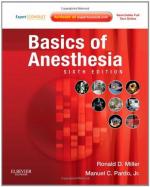|
This section contains 1,332 words (approx. 5 pages at 300 words per page) |

|
Anesthesia is the loss of sensation of painful stimuli either with or without loss of consciousness. Anesthetic agents produce a state of anesthesia. Anesthetics can be broken down into two basic categories: general anesthetics (those that cause loss of consciousness), and local or regional anesthetics ( those that do not cause a loss of consciousness but rather "deaden" or "numb" the area).
The history of general anesthesia begins in ancient times with the inhalation of opium and other plant alkaloids. In the recent past dentists were instrumental in the introduction of diethyl ether and nitrous oxide. In 1846 William T. G. Morton (1819-1868), a Boston dentist, gave his famous demonstration of ether in the "ether dome" of the Massachusetts General Hospital. Morton was late for the procedure, and as he ran into the operating theater the surgeon, Doctor Warren, remarked, "Well, sir, your patient is ready." There surrounded by a...
|
This section contains 1,332 words (approx. 5 pages at 300 words per page) |

|


